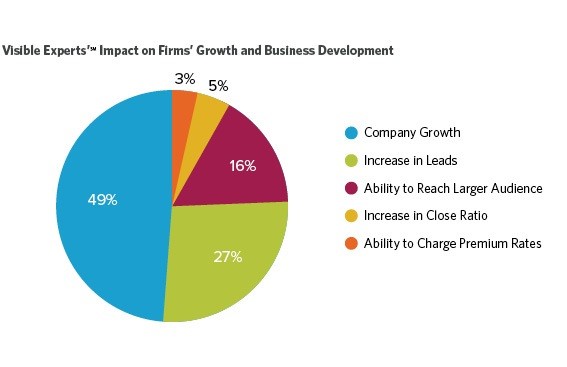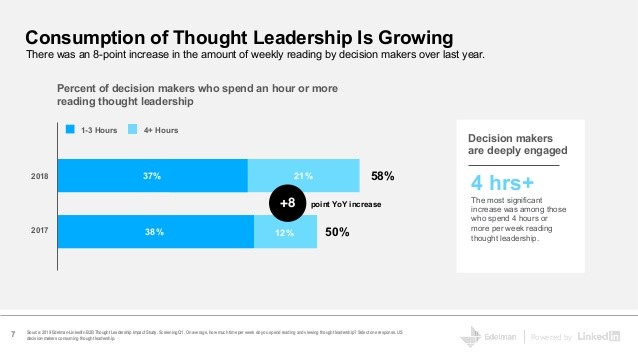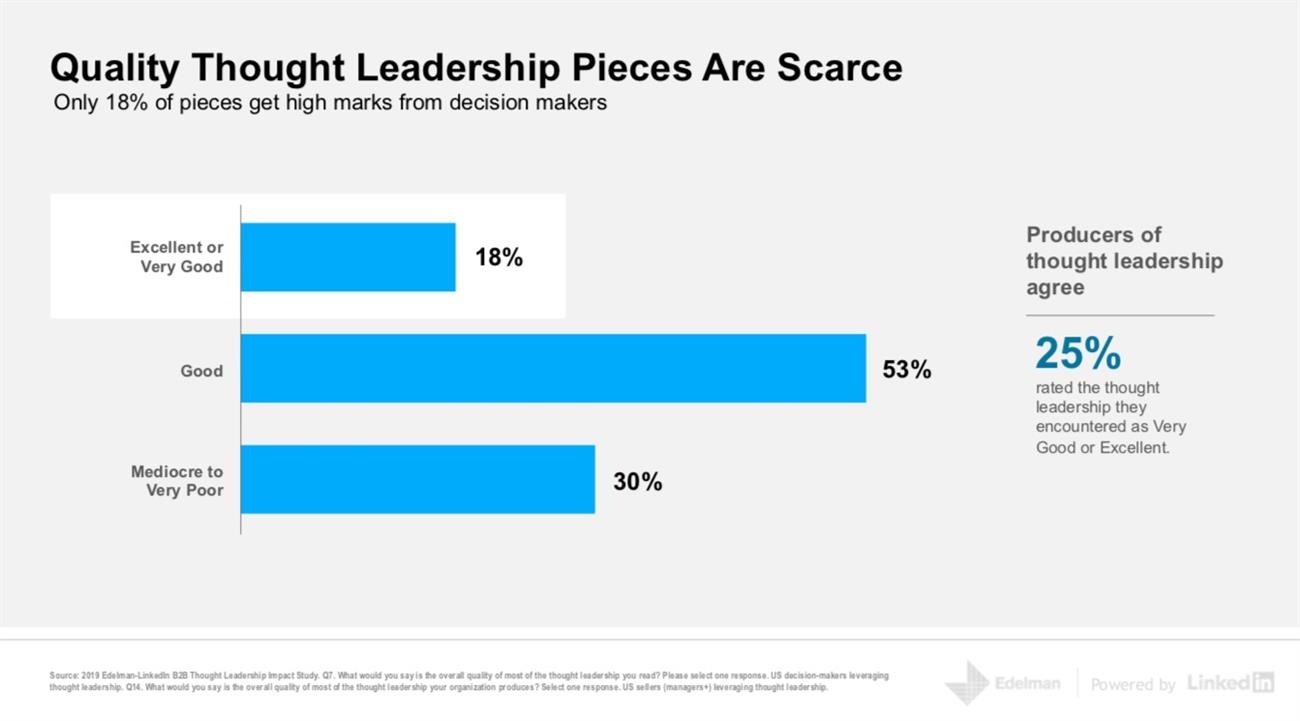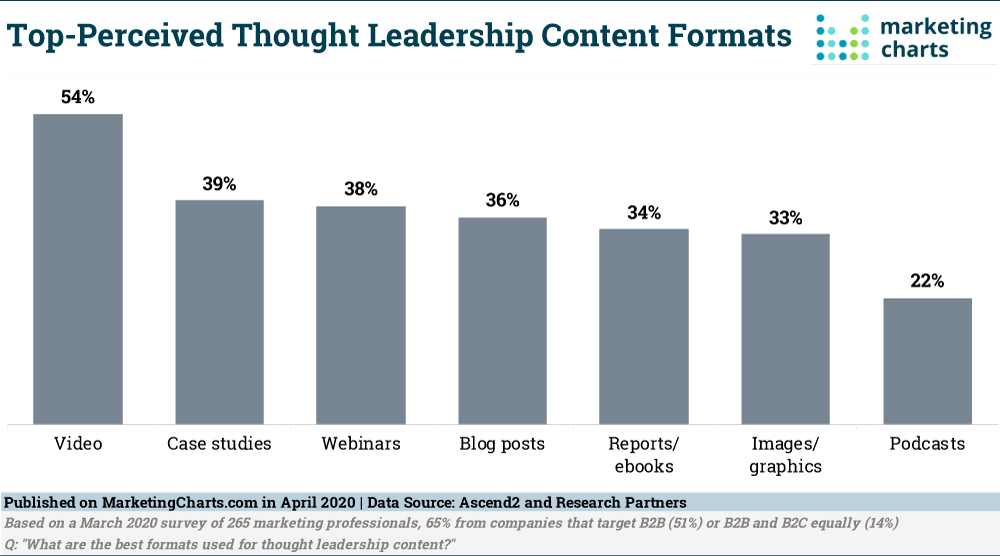The uniqueness of any venture depends on the connection and the interpersonal feeling it offers through its brand voice. That’s precisely what thought leadership in technology demands. So, you’re considered a thought leader if you make goal achievement easy for your consumers through your products or services.
More than 90% of the buyers demand thought leadership content across all mediums to comprehend the specialty of an enterprise. That means the business marketing strategy needs to factor in all the aspects of the enterprise’s journey. This includes product details, organizational ecosystem, and industry knowledge.
With an accurate thought leadership strategy, your business can be considered an industry expert along with other benefits. But the technology industry is facing trouble in including the crucial concept in their business strategy.
Read on to know about what thought leadership roadblocks stop a tech business from getting comprehensive growth!
Advantages of thought leadership

Source: Hingemarketing
Thought leadership in technology is all about providing your customers with the best and most valuable answers to their tricky questions. This marks the businesses as the real solution-generator in the tech industry.
Thought leadership advantages go beyond merely establishing a business as the tech industry expert. Some of the exceptional benefits include:
Credibility
In technological domains, it’s essential your clients and consumers perceive you as the expert in the services you provide. Being a thought leader ensures that the audience views the business as an excellent source of solutions to alleviate their troubles. It’s so effective that 47% of buyers prefer to purchase from businesses with strong thought leadership than even the industry giants.
Competitive Edge
With every other company trying to leverage the same tech-related trends like AI, differentiation is the key to success. Thought leadership provides you the avenue to offer something more valuable than your competitors. Essentially, it induces the human tone and empathy in your business strategies to create brand loyalty which is challenging to replicate.
Case Study: Starbucks
Starbucks redefined the perception of the ‘first-morning coffee’ through its thought leadership strategy of including comfort in its ambiance. Its core value reflects in the constant innovation and initiatives the brand undertakes, like recyclable cups to reduce pollution.
Revenue Generation
The basic tenet of thought leadership is confidence in the value offered. Especially in the tech industry, trust in the expertise provided helps gauge the prices more effectively.
One of the most important thought leadership advantages is the inculcation of trustworthiness across all the stakeholders of a business. Not only does this enhances the consumer’s attention and sales, but it also streamlines internal efficiency to cut down unnecessary expenses.
Higher Satisfaction
Being a thought leader establishes you as a true entrepreneur.
After all, a business is all about creating solutions for challenges. It helps you leverage the opportunity to offer a better product and service that simultaneously reflects your passion for your niche and productivity. It also avails the professionals to curate out-of-the-box merchandise leading to higher job satisfaction and employee retention.
Innovation
Thought leadership propels an organization to think beyond the current market sphere. This presents an opportunity to reach beyond the mainstream and offers higher adaptability with experimentation. The focus on long-term inclusive growth allows your business to grow with robust research and innovation.
For instance, Meta offers an immersive experience to its audience for connecting and building personal as well as business relationships. It does so through its consumer-centric but future-oriented model.
Thought leadership challenges modern businesses face
Despite thought leadership being the latest buzzword across all businesses, its articulation is where tech companies falter. Essentially the ventures run behind the trends such as big data, machine learning, etc., without thinking twice about their relevance. That creates confusion in the brand image and the precise solution it’s offering.
Here are the challenges you need to look out for if you’re planning to include thought leadership in your venture:
Current Product/Service-Centric Tunnel Vision
Well-defined thought leadership in technology understands the potential of the services or the products offered. However, most companies limit themselves to selling the ‘features’ instead of showing the ‘value’ they will create to the audience.
In addition, only focusing on the current product leads to unidirectional growth. It leads to disassociation of your consumers whenever you start expanding in a different niche of the same domain.
The ‘How-to’ and ‘What’ Mismatch
With different tech companies offering various analytical and technical services, it gets confusing for your consumers to comprehend the exact solution offered. In addition, the tech industry complicates the matter by not understanding the audience’s demand.
Instead of just the specifications, the customers require a way of using the services offered. 64% of buyers assess the trustworthiness of a business by the kind of thought leadership content it offers beyond the product sheets.
No Cross-Leader Collaborations

Source: wtwhmedia
Attestation is as important as establishing thought leadership in the technology sector. The most pertinent issue with IT companies is their reluctance to appreciate the work of the industry experts. Not only does it reflect poorly on the organization, but it also fails to leverage the opportunity to provide a diverse knowledge base to its audience.
Failure to harness multi-channel mediums
Understanding your audience requires a tech business to listen across various platforms. Whether on Twitter or on the ground, you need to open your eyes and ears to maximize your social listening potential. It’s essential that enterprises keep track of the engaging audience with competitors to understand where they need to position themselves for enhanced visibility.
Being too technical

It’s understandable that a tech company will enlist its products with heavy industry jargon, but it doesn’t pan out well for the consumers. Not gauging how to simplify the buyer’s journey creates a tricky challenge for the technology companies to take care of.
Not putting out timely content in desired formats

Source: Marketingcharts
Being the first one has its advantages that tech companies must leverage. When you share knowledge that only a few know about, you establish yourself as the authority in the industry. However, not harnessing the first-come-first-served opportunity leads to a reduced flow of prospects in your marketing funnel. This causes you to face higher competition and poorer performance.
On top of this, understanding the most consumer-friendly format is also crucial before undergoing the creation process.
Case studies for organizations that incorporated thought leadership
Thought leadership in technology portrays the excellence of the company while showing them in the most human light. This enables the consumers to build a higher affinity with the brand. Here’re a few leading examples you can take inspiration from:
i). IBM
The tech giant has allotted a different segment on its webpage to showcase the brilliance of the tech innovators. On the page, the company discusses the latest trends and discussions in the technological sector. They capture a variety of tricky topics to share with its audience, such as cloud computing, AI, etc.
IBM has also spectacularly managed to include the lesser-known thought leaders in the tech sector and their contributions to the world.
The brand paves the way as a perfect example of cross-collaboration for thought leadership in technology.
ii). Accenture
Another brilliant example of thought leadership in technology includes Accenture.
The company creates one of the most thought-provoking and prolific contents with tech-infused knowledge. It offers businesses a platform to gain the requisite industry knowledge and insight to seize opportunities and build a better future.
iii). PubNub
PubNub is a real-time visualization company that offers technologies and interactive interfaces to capture data as soon as it changes. This not only helps different companies to use digital information but also avails them of the convenience of faster decision-making.
The brand positions itself as fantastic inspiration for customer-centric thought leadership because of the immersive experience it creates for the services it provides. To do so, it curates content only around the images and visualizations available on the brand page.
iv). Kaltura
It is a video-cloud-based platform that aims to augment video experiences without any geographic location. From onboarding videos to learning tutorials, the brand lets you create large files for streaming, training modules as well as screen recording.
One of the easiest ways through which the brand has harnessed thought leadership is by offering its content in the form of the solution they provide. Across their page, you can find a range of topics and discussions that portray how organizations are utilizing their services.
v). Salesforce
The world’s customer relationship management company is also one of the thought leaders in the tech industry. The brand conducts multiple surveys on various industry trends to assist the world in creating solutions and tackling challenges. One of the most helpful studies from Salesforce includes small-to-medium-sized business trends, which it carries out every alternate quarter.
FAQs
1. What is thought leadership in technology?
Thought leadership in technology involves providing solutions to the challenging issues at hand while considering the requirements of the proposed idea. Besides offering the most viable solution, it also aims at delivering it in the most helpful manner to the audience.
2. What are the benefits of thought leadership?
The main advantage of thought leadership translates into developing a comprehensive company culture. In addition, it also helps with:
- Enhancing customer perception
- Higher brand affiliation
- Improved solutions using the latest trends and in-depth research
- Increase in innovation
- Boost job satisfaction
- Increased sales and overall profitability
- Higher efficiency for future-centric decisions
- Augmented customer outreach and higher industry authority
3. What is the significance of thought leadership?
Thought leadership helps establish you as an industry expert based on the quality content you provide, along with practical solutions. Moreover, it enhances your public appeal and trustworthiness across your domain.
4. How can you improve thought leadership?
Thought leadership is about offering solutions to your consumers in a manner that’s most useful to them. To improve your leadership, you need to:
- Listen to your audience and comprehend the exact problem they are facing.
- You must offer consistent value to your consumers to increase your thought leadership skills.
- Get into the intricacies of the current trend and offer an authoritative analysis of the same.
- Curate content around fresh and new ideas that no one else has answered yet.
- Repurpose your pre-created content in easy-to-understand forms and materials.
- Avoid using heavy, technical jargon and aim to simplify the consumer journey through an easily understandable piece.
5. What are some strategies to use for thought leadership in technology?
To demonstrate thought leadership, you must come across as a subject matter expert. These strategies will establish your authority as one:
- Share your content from the point of view of offering service instead of garnering sales.
- Reach out to your consumers on the platform they find the most convenient.
- Carefully create your unique content by understanding the sentiments of the market.
- Collaborate with other industry experts to bring a more comprehensive solution through your offered solution.
- Stick to the precise message that you want your audience to trust you with.
Conclusion
The concept of thought leadership is exactly as it sounds. With more awareness amongst the consumers, nowadays, businesses are not only about the products and services they offer, but rather the wholesome experience, I.e., a well-thought one.
As easy and lucrative as it appears, thought leadership isn’t a cakewalk. With the tech sector offering analytical solutions, it becomes difficult for organizations to simplify the delivery to their consumers.
Unlike in 1984, today, customers get alienated from excessive use of business language. It not only reduces the brand credibility but also narrows your sales funnel. That’s why empathetic thought leadership not only helps you stand out but also opens the door for higher profitability.
In order to establish robust thought leadership in technology, it’s imperative that individuals and companies learn from the past to analyze the present. This will ensure that a well-researched and comprehensive solution comes into existence instead of sales-hungry services.







